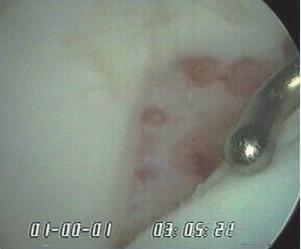
 by Mark Hurtig
by Mark Hurtig
Dept. of Clinical Studies,
Ontario Veterinary College
Guelph, ON, N1G 2W1 |
The
Art of Treating Equine Joint Disease:
new surgical technique saves horses |
With the emphasis
on healthier and more active lifestyles, competitive sports are attracting
people well into their later years. Horse owners are expecting the same
of their mounts. Many hard working hunt, dressage, and three-day event
horses can be highly competitive in their late teens and early twenties.
Injuries, however, are a fact of life for both people and horses. This
is particularly true for those involved in competitive sports. Often these
injuries occur early in life and are career-limiting. Now, with specialized
mosaic arthroplasty techniques, the rehabilitation of many competitive
horses with previously untreatable joint injuries is possible.
Joint injuries are
a major cause of economic loss in the horse industry. Even a small cartilage
injury in a critical spot can end a successful career. While the knee
is the most problematic site for the human runner, injuries in the equine
carpal (knee) and fetlock joints in the front limb are limiting for the
horse. Cartilage in these high motion joints does not heal in adult horses.
Medications in the glucosamine sulfate, non-steriodal anti-inflammatory
and hyaluronate families are ineffective treatments for the kind of cartilage
and bone injury that we often see in competitive horses.
Another approach to
joint injury is to resurface the site with a graft. Synthetic materials
and crude cartilage grafts have been tried, but both types were easily
damaged
and had problems with attachment to the underlying bone. In human orthopedics,
grafting is relatively successful in difficult cases where a tumor or
injury has destroyed all or part of a joint. These large grafts are sometimes
harvested from another part of the same joint as an autograft, or as an
allograft from an organ donor program.
A more recent innovation
in sports medicine is using small cylindrical autografts to resurface
a symptomatic cartilage defect, in the manner that small tiles make up
a mosaic. With our comparative orthopedic research group at the University
of Guelph this technique, called mosaic arthroplasty, is being refined
by Dr. Anthony Miniaci, an orthopedic surgeon at Toronto Hospital (Western
Division).
We deliver the grafts
to precisely drilled holes in the damaged area as small cylinders, like
dowels, in an evenly spaced pattern. Our research has shown that a group
of three larger diameter grafts (4.5 or 6.5mm) was more successful than
a group of smaller diameter ones (2.7mm). The smaller grafts were fragile
and the bony portion of the graft healed poorly. Larger grafts were easier
to position to reconstruct complex, curved contours.
Accuracy of graft
delivery is essential in areas where the cartilage is thin, such as in
the equine carpus (knee). We must exactly match the levels of graft and
host cartilage, otherwise mechanical damage and loosening of the graft
result.
The greatest advantage
of mosaic arthroplasty for horses is that the entire procedure can be
done arthroscopically with out the need for a large incision. As a result,
previously untreatable injuries in the carpus, fetlock, hock and stifle
are now potentially treatable. Some investigations involving allografts
are also underway. Allografts, taken from another recently euthanatized
or slaughtered horse, have the advantage of being an exact match for the
damaged site, but do have the potential complication of immune rejection.
Through our research
we have developed specialized mosaic arthroplasty techniques; and with
the help of Smith and Nephew Endoscopy adapted instruments for the horse.
Preliminary results in the equine carpal joint are encouraging and, like
Dr. Miniaci, we are offering mosaic arthroplasty to carefully selected
patients in our surgical practice. The people and horses that are most
likely to benefit are those with small, focal, joint cartilage injuries.
Patients with chronic, longstanding injuries, osteoarthritis and unstable
joints are unsuitable candidates for this technique.

Horses with small focal injuries are the most suitable candidates for
mosaic arthroplasty, a grafting technique proving useful in halting debilitating
joint disease. Dr. Mark Hurtig and his team of researchers have adapted
for horses leading-edge surgical techniques used in human athletes.
Longer-term studies
and clinical trial are beginning. The success of cartilage transplantation
in controlling joint disease in horses is of significant interest. Reducing
the cost of treating chronic joint disease, which includes anti-inflammatory
and intra-articular medication, as well as lost training days and lost
winnings, would mean real saving to the horse owner.
The researchers would
like to acknowledge the generous support of the Ontario Ministry of Food,
Agriculture and Rural Affairs (OMAFRA) and the Morris Animal Foundation.
|

